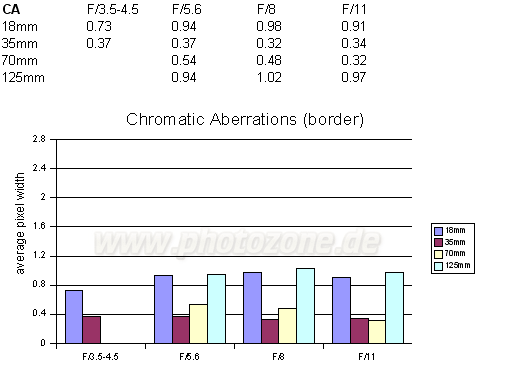|
Sigma AF 18-125mm f/3.5-5.6 DC (Pentax K) - Review / Lab Test Report - Analysis |
|
Lens Reviews -
Pentax
|
|
Page 2 of 2

Distortion
A major weakness of most long range zoom lenses is the level of distortion and the Sigma is no exception.
At 18mm the lens produces a very pronounced degree of barrel distortion changing to pronounced pincushion
distortion from 35mm onwards. If you´re looking for a lens for architecture photography this one is
clearly not for you.
|
Move the mouse cursor over the focal length text marks below to observe the respective distortion
|
| 18mm |
35mm |
70mm |
125mm |
|

|
The chart above has a real-world size of about 120x80cm.
Vignetting
Typical for most dedicated APS-C lenses the Sigma produces quite strong vignetting.
At 18mm the vignetting exceeds 1.3EV so stopping down to at least ~f/5.6 is generally a
good idea here. The problem isn't quite as pronounced at the other tested focal
lengths but you have to be careful towards the long end of the zoom range where the
vignetting increases again to more than 1EV @ 125mm f/5.6.

MTF (resolution)
The Sigma has already been tested with surprisingly good resolution results within the
Canon scope . However, the 10 megapixel Sony sensor used in the Pentax K10D
is slightly bigger thus pushing the borders a bit more towards the end of the supported
image circle of the lens - this is not without impacts specifically in the extreme
corners of the image field.
At 18mm the center and border performance is very high throughout the tested aperture
range. However, the extreme corners are soft at f/3.5 although they recover nicely
at f/5.6 and more so at f/8. The situation is fairly similar at 35mm. At 70mm and 125mm
there's a slight drop in performance - less so in the center which remains on a very
good level even at wide-open aperture - but the border performance drops down to
fair or good (just) levels. Stopping down to f/8 or f/11 boosts the borders quality
to pretty high levels though.
Please note that the MTF results are not directly comparable across the different systems!
Below is a simplified summary of the formal findings. The chart shows line widths per picture height (LW/PH) which can be taken as a measure for sharpness.
If you want to know more about the MTF50 figures you may check out the corresponding Imatest Explanations
Chromatic Aberrations (CAs)
It may be surprising but the Sigma actually manages to produces a comparatively
low degree of lateral chromatic aberrations (color shadows at harsh contrast
transitions) with a peak around 1px on the average at the image borders at 18mm
and 125mm and even less in between.

Sample Images
I've published some sample images in the review of the Canon variant of this lens.
Verdict
The Sigma AF 18-125mm f/3.5-5.6 DC is naturally a bit of compromise solution but
the overall package is actually quite sound especially when taking the low price
tag into account. The lens is pretty sharp when stopped down a little and CAs are
surprisingly low for such an extreme zoom. However, the vignetting could be a
little better at wide-open aperture specifically at the 18mm and 125mm setting
and the level of distortions is very high throughout the zoom range. Nonetheless
these are viable compromises for a compact 7x zoom. The Canon variant of the lens
showed a miserable AF performance on the EOS 350D but the Pentax K10D has obviously
a superior AF module which can handle the task quite well although the AF speed
diminishes significantly in low light situations - this may be very different on
smaller or older Pentax DSLR with a less capable AF system so if you own one of
these better check this aspect if you're interested in this lens.
| Optical Quality: |  |
| Mechanical Quality: |  |
| Price/Performance: |  |
|